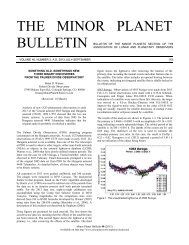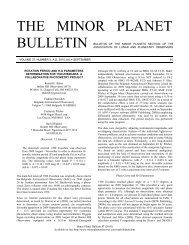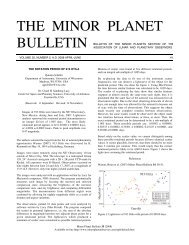THE MINOR PLANET BULLETIN - MinorPlanet.Info
THE MINOR PLANET BULLETIN - MinorPlanet.Info
THE MINOR PLANET BULLETIN - MinorPlanet.Info
- No tags were found...
You also want an ePaper? Increase the reach of your titles
YUMPU automatically turns print PDFs into web optimized ePapers that Google loves.
125<br />
ASTEROIDS OBSERVED FROM GMARS AND SANTANA<br />
OBSERVATORIES: 2009 JANUARY - FEBRUARY<br />
Robert D. Stephens<br />
Goat Mountain Astronomical Research Station (GMARS)<br />
11355 Mount Johnson Court, Rancho Cucamonga, CA 91737<br />
RStephens@foxandstephens.com<br />
(Received: 2009 Apr 12)<br />
Lightcurves for 654 Zelinda, 946 Poesia, and 1655<br />
Comas Sola were obtained from Santana and GMARS<br />
Observatories in 2009 January and February.<br />
Observations at Santana Observatory (MPC Code 646) were made<br />
with a 0.30-m Schmidt-Cassegrain (SCT) with a SBIG STL-<br />
1001E. Observations at GMARS (Goat Mountain Astronomical<br />
Research Station, MPC G79) were made with two telescopes, both<br />
0.35-m SCT using SBIG STL-1001E CCD Cameras. All images<br />
were unguided and unbinned with no filter. Measurements were<br />
made using MPO Canopus, which employs differential aperture<br />
photometry to produce the raw data. Period analysis was done<br />
using Canopus, which incorporates the Fourier analysis algorithm<br />
(FALC) developed by Harris (1989). The asteroids were selected<br />
from the list of asteroid photometry opportunities published on the<br />
Collaborative Asteroid Lightcurve Link (CALL) website (Warner<br />
et al., 2008).<br />
654 Zelinda. 654 Zelinda had a favorable opposition in 2009.<br />
Images were obtained on February 11, 19, 20 and 21 with the<br />
0.30-m SCT at Santana Observatory. All others were obtained<br />
with the 0.35-m SCT at GMARS. Warner and Higgins (2008)<br />
obtained a lightcurve in 2008 September, reporting a period of<br />
32.0 ± 0.1 h. Schrober (1975) reported a period of 31.9 ± 0.05 h<br />
with a U = 2 rating.<br />
946 Poesia. Images on January 19 and 28, and February 3 and 4<br />
were obtained with the 0.30-m SCT at Santana Observatory. All<br />
others were obtained with the 0.35-m SCT at GMARS. The data<br />
were linked to an internal standard using a method developed by<br />
Warner (2007) and described by Stephens (2008) included in the<br />
latest release of Canopus. No previously reported result has been<br />
published.<br />
References<br />
Addleman, D., Covele, B., Duncan, A., Johnson, J., et al. (2005).<br />
Minor Planet Bul. 32, 76-78.<br />
Behrend, R. (2009). Observatoire de Geneve web site,<br />
http://obswww.unige.ch/~behrend/page_cou.html<br />
Harris, A.W., Young, J.W., Bowell, E., Martin, L.J., Millis, R.L.,<br />
Poutanen, M., Scaltriti, F., Zappala, V., Schober, H.J., Debehogne,<br />
H., and Zeigler, K.W. (1989). “Photoelectric Observations of<br />
Asteroids 3, 24, 60, 261, and 863.” Icarus 77, 171-186.<br />
Schober, H.J. (1975). Astron. Astrophys. 44, 85-893<br />
Stephens, R.D. (2008). “Long Period Asteroids Observed from<br />
GMARS and Santana Observatories.” Minor Planet Bul. 35, 31-<br />
32.<br />
Warner, B.D. (2007). “Initial Results from a Dedicated H-G<br />
Project.” Minor Planet Bul. 34, 113-119.<br />
Warner, B.D., Harris, A.W., Pravec, P. (2008). Asteroid<br />
Lightcurve Parameters http://www.<strong>MinorPlanet</strong>Observer.com/<br />
astlc/default.htm.<br />
Warner, B.D. and Higgins, D. (2008). “Lightcurve Analysis of 654<br />
Zelinda.” Minor Planet Bul. 35, 32-33.<br />
654 Zelinda 946 Poesia<br />
1655<br />
Comas Sola<br />
Dates 01/17–02/21 01/01–02/04 12/31-01/16<br />
Data Pts 5,126 1,938 1,962<br />
α 8.7, 22.2 6.5, 8.7 7.6, 15.4<br />
Avg L PAB 123 116 88<br />
Avg B PAB -14 1 -4<br />
Per. (h) 31.735 108.5 20.456<br />
PE (h) 0.01 0.5 0.004<br />
Amp (mag) 0.12 0.32 0.22<br />
AE (mag) 0.02 0.05 0.03<br />
Table 1. Observing circumstances. Dates are in 2009, except for the<br />
first observation of 1655, which was 2008.<br />
1655 Comas Sola. Images on January 1 were obtained with the<br />
0.35-m SCT at GMARS. All others were obtained with the 0.30-m<br />
SCT at Santana Observatory. Addleman (2005) obtained a partial<br />
lightcurve at Rose-Hulman Institute of Technology and reported a<br />
period of 20.4 ± 0.1 h, in good agreement with this result. Behrend<br />
(2009) reported a period of greater than 12 h.<br />
Acknowledgements<br />
Thanks are given to Dr. Alan Harris of the Space Science Institute,<br />
Boulder, CO, and Dr. Petr Pravec of the Astronomical Institute,<br />
Czech Republic, for their ongoing support of amateur asteroid<br />
research. Also, thanks to Brian Warner for his continuing work<br />
and enhancements to the software program MPO Canopus which<br />
makes it possible for amateur astronomers to analyze and<br />
collaborate on asteroid rotational period projects and for<br />
maintaining the CALL Web site which helps coordinate<br />
collaborative projects between amateur astronomers.<br />
Minor Planet Bulletin 36 (2009)










